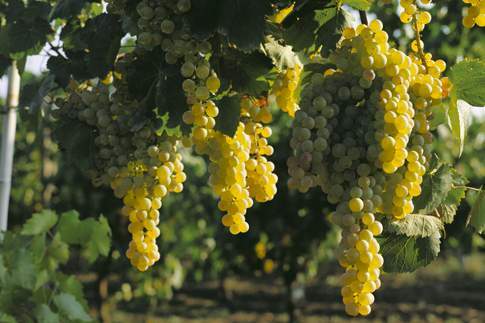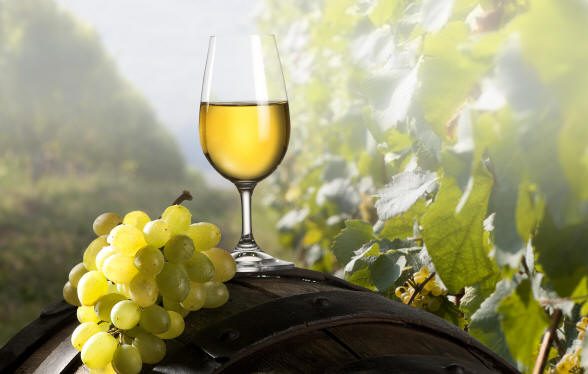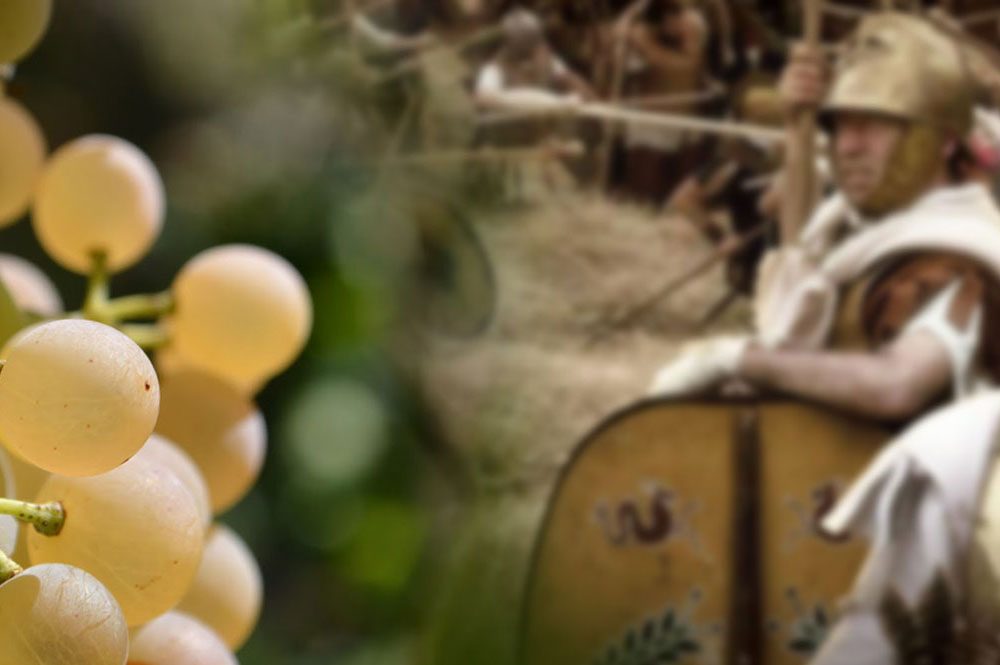{: it}
The Marche, with their picturesque hilly landscape overlooking the sea, represents an ideal territory for the cultivation of some particular varieties of wine grapes, including Bianchello del Metauro.
The vine Biancollo del Metauro, or Biancame, is characterized by a pale-coloured berry and is typical of the northernmost area of the Marche, in the province of Pesaro and Urbino, involving the entire valley, from Fano to Urbania, passing through Pergola and Fossombrone.
Il Biancollo del Metauro has remote origins, it is in fact estimated that production was already active in 500 BC while the first written testimonies come to us from Tacito, one of the greatest historians of antiquity. The link between Roman history and the Marche region is very deep. In the province of Pesaro and Urbino the signs of Roman domination are still visible: arches, walls, pavements and streets are perfectly inserted into our daily lives, reminding us every day of what our past was.
Not just architecture and roads: the Romans established traditions, such as Augustus holidays (the pagan origin of what we now call Ferragosto) which still resist, albeit in a revisited, modern and/or religious form. Even food and wine have done their part to contribute to the link between ancient and modern and, precisely in the story of Tacito, war and wine meet and clash.
The vine Biancollo del Metauro, or Biancame, is characterized by a pale-coloured berry and is typical of the northernmost area of the Marche, in the province of Pesaro and Urbino, involving the entire valley, from Fano to Urbania, passing through Pergola and Fossombrone.
Il Biancollo del Metauro has remote origins, it is in fact estimated that production was already active in 500 BC while the first written testimonies come to us from Tacito, one of the greatest historians of antiquity. The link between Roman history and the Marche region is very deep. In the province of Pesaro and Urbino the signs of Roman domination are still visible: arches, walls, pavements and streets are perfectly inserted into our daily lives, reminding us every day of what our past was.
Not just architecture and roads: the Romans established traditions, such as Augustus holidays (the pagan origin of what we now call Ferragosto) which still resist, albeit in a revisited, modern and/or religious form. Even food and wine have done their part to contribute to the link between ancient and modern and, precisely in the story of Tacito, war and wine meet and clash.

Il white goods or Bianchello is a white grape characteristic of the northern Marche, where it is grown in the area of the Metauro riverbed.

Bianchello del Metauro with a straw yellow colour, odor delicate, flavor dry, fresh, harmonious.
Tacito he told in his writings how Hasdrubal, brother of Hannibal, lost the battle of Metauro partly due to this wine called “White white”. The battle, included among the decisive clashes of the Second Punic War, was fought in 207 BC right near the Metauro river. Hasdrubal he was attempting to lead the Carthaginians to Rome, to help his brother in the siege, but was stopped by the Romans. Despite the Spanish elephants and the accompanying Gaulish army, Hasdrubal – probably outnumbered – lost the battle, also thanks to the revelry of the day before.
Time has passed and anyway the White white has remained one of the distinctive dry wines of the Marche, with its fruity and delicate aroma of white peaches and its straw yellow, almost crystalline colour. Not only that, this type of wine with a not too high alcohol content marries in all respects the characteristics of the territory in which it is produced, making it perfect as an accompaniment to molluscs, crustaceans and delicate fish dishes, as well as rice and pasta.
Il Bianchello del Metauro DOC it then gave life to the Superiore variants - more structured and savory -, Spumante - sparkling and with stronger citrus tones - and Passito, derived from the dehydration of grapes and characterized by the flavor of honey and dried apricots.
It is loved by many, both Marche residents and tourists, for its simplicity and freshness. So widespread throughout the territory, we now know that this wine not only boasts a long and consolidated history, but also a fundamental role in the fate of the Carthaginian army and the Romans themselves.
The Marche Region – with its picturesque hilly landscape overlooking the Adriatic sea – represent an ideal area for the cultivation of some particular wine grapes, such as Bianchello del Metauro.
The vine variety of grapes named Biancollo del Metauro, Or White me, is distinguished by its pale color and is typical of the northern part of the Marche region, in the Province of Pesaro Urbino, the whole valley from the city of Fano up to Urbania, in-between the towns of Pergola and Fossombrone.
Biancollo del Metauro has ancient origins, its production dates back to 500 Before Christ, while first documents come from writings of famous Roman historian Tacitus. There is a deep connection between Roman history and the area of the Marche region. There are several proofs of Roman domination on the area of the Province of Pesaro Urbino: arches, walls, paving and streets have been absorbed by our contemporary everyday life, so that we can remember our past.
Not only architecture and roads: Romans had traditions, like for instance the Holidays of Emperor Augustus (“Feriae Augusti”, the pagan origin of our contemporary “Ferragosto”, i.e. Italian Public Holiday celebrated on 15 August) that remains, though it is updated in a modern and/or religious way, and indeed in Tacitus' reports war and wine bump into each other.
The vine variety of grapes named Biancollo del Metauro, Or White me, is distinguished by its pale color and is typical of the northern part of the Marche region, in the Province of Pesaro Urbino, the whole valley from the city of Fano up to Urbania, in-between the towns of Pergola and Fossombrone.
Biancollo del Metauro has ancient origins, its production dates back to 500 Before Christ, while first documents come from writings of famous Roman historian Tacitus. There is a deep connection between Roman history and the area of the Marche region. There are several proofs of Roman domination on the area of the Province of Pesaro Urbino: arches, walls, paving and streets have been absorbed by our contemporary everyday life, so that we can remember our past.
Not only architecture and roads: Romans had traditions, like for instance the Holidays of Emperor Augustus (“Feriae Augusti”, the pagan origin of our contemporary “Ferragosto”, i.e. Italian Public Holiday celebrated on 15 August) that remains, though it is updated in a modern and/or religious way, and indeed in Tacitus' reports war and wine bump into each other.

White me or Bianchello is a white grape variety typical of the northern part of the Marche region, where it is cultivated in the area of the river Metaurus.

Bianchello del Metauro, with is pale yellow, delicate aroma, dry fresh and round taste.
Tacitus tells that Hasdrubal, Hannibal's brother, lost the Battle of Mataurus because of the wine named “White white”. The battle took place in the area of the river Metaurus in 207 Before Christ, during the Second Punic War. Hasdrubal wanted the Carthaginians to reach Rome, to help his brother during the siege, but he failed and was stopped by the Roman army. Instead of Spanish elephants and the supporting Gallic army, Hasdrubal – probably outnumbered – lost the battle, also due to the previous day partying with wine.
Time has gone but Biancollo del Metauro remains today one of the typical dry wines in the Marche region, with its fruity and delicate aroma and its pale and almost crystal yellow. The wine is not particularly strong in alcohol and truly represents the characteristics of its production area, perfect in its flavor for shellfish, crustacean and delicate fish dishes, but also of pasta and risotto.
Bianchello del Metauro DOC (Denomination of Controlled Origin) also includes its “Superiore” variety which is more structured and savory, “Spumante” with its sparkles and citrusy taste, and “Passito” derived from dehydration of grapes with its honey and dry apricot tastes.
Many tourists and local people appreciate this wine for its fresh and simple taste. It is spread over the area, we know it keeps a long and happy history, but also it had a key role during the war between Roman and Carthaginian armies.

